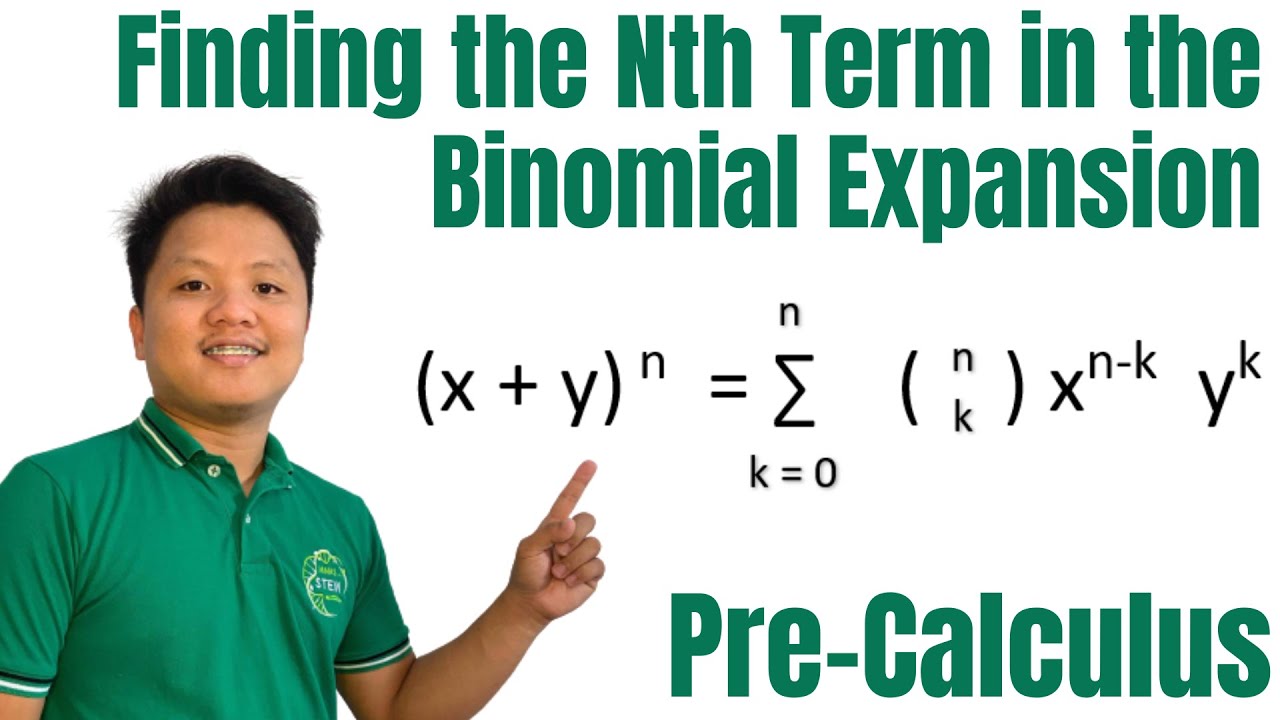Binomial Expansion Using Pascal's Triangle | Pre-Calculus
TLDRThis educational video demonstrates how to use Pascal's Triangle to expand binomials. The host explains the process step-by-step, starting with the basics of binomial expansion and moving on to practical examples. First, they show how to expand (a + b) to the 8th power using the coefficients from Pascal's Triangle. Then, they apply the same method to expand the expression (2x - 3y) to the 5th power. The video is a helpful resource for understanding the pattern of coefficients in polynomials and offers clear examples to illustrate the concepts.
Takeaways
- 📚 The video is an educational tutorial focused on expanding binomials using Pascal's Triangle.
- 🔢 Pascal's Triangle is used to expand binomials raised to various powers, such as (a + b)^n.
- 📈 The coefficients of the expanded binomial follow a pattern that mirrors the numbers in Pascal's Triangle.
- 📝 The script provides step-by-step examples of how to use Pascal's Triangle to expand (a + b)^2 and (a + b)^3.
- 📚 The video explains how to apply the coefficients from Pascal's Triangle to the terms of the binomial raised to a power.
- 📘 The script includes an example of expanding (a + b)^8 using the 8th row of Pascal's Triangle.
- 📙 The video also demonstrates how to expand the expression (2x - 3y)^5 using Pascal's Triangle.
- 📋 Each term in the expansion is calculated by multiplying the binomial's terms raised to the appropriate powers as indicated by the coefficients from Pascal's Triangle.
- 📌 The final expanded form of the binomial is a polynomial that includes all the terms from the binomial raised to its respective powers.
- 👨🏫 The video is presented by Prof D, who encourages viewers to ask questions or seek clarifications in the comments section.
Q & A
What is Pascal's Triangle and how is it used in the context of the video?
-Pascal's Triangle is a triangular array of the binomial coefficients. Each number in the triangle is the sum of the two numbers directly above it. In the video, it is used to expand binomial expressions by identifying the coefficients for the expanded terms based on the rows of the triangle.
How does the video demonstrate the expansion of (a + b)^1?
-The video shows that when (a + b) is raised to the power of 1, the expansion is simply a + b, as there is only one term with a coefficient of 1 for both a and b.
What is the expanded form of (a + b)^2?
-The expanded form of (a + b)^2 is a^2 + 2ab + b^2, which corresponds to the binomial square with coefficients 1, 2, and 1 from the second row of Pascal's Triangle.
How does the pattern of coefficients in the polynomial follow when expanding (a + b)^n?
-The pattern of coefficients follows the row of Pascal's Triangle corresponding to the power n. Each coefficient in the expanded polynomial is the number from the Pascal's Triangle row that matches the term's exponent.
What is the process to expand (a + b)^8 using Pascal's Triangle?
-To expand (a + b)^8, you start with the eighth row of Pascal's Triangle, which is 1, 8, 28, 56, 70, 56, 28, 8, 1. Each number in this row serves as a coefficient for the corresponding term in the expansion, with the powers of a and b decreasing sequentially from a^8 down to b^8.
How does the video simplify the expanded form of (2x - 3y)^5?
-The video uses the fifth row of Pascal's Triangle (1, 5, 10, 10, 5, 1) to find the coefficients for the expanded form of (2x - 3y)^5. It then multiplies each coefficient by the corresponding powers of 2x and -3y, and simplifies the terms to get the final polynomial.
What is the first term in the expanded form of (a + b)^8?
-The first term in the expanded form of (a + b)^8 is a^8, which comes from the first number in the eighth row of Pascal's Triangle, with a coefficient of 1.
What is the coefficient of the term with a^7b in the expanded form of (a + b)^8?
-The coefficient of the term with a^7b in the expanded form of (a + b)^8 is 8, as indicated by the second number in the eighth row of Pascal's Triangle.
How does the video show the expansion of (2x - 3y)^5?
-The video shows the expansion of (2x - 3y)^5 by using the coefficients from the fifth row of Pascal's Triangle and applying them to the terms of the binomial, taking into account the signs and the powers of x and y.
What is the last term in the expanded form of (2x - 3y)^5?
-The last term in the expanded form of (2x - 3y)^5 is -243(2x)^0(-3y)^5, which simplifies to -243y^5, using the last number in the fifth row of Pascal's Triangle.
How does the video ensure that the binomial expansion is correctly applied?
-The video ensures the binomial expansion is correctly applied by demonstrating the process step by step, starting from the first term and using the coefficients from Pascal's Triangle to find the subsequent terms, until the last term is reached.
What is the significance of the binomial coefficients in Pascal's Triangle?
-The binomial coefficients in Pascal's Triangle are significant because they provide the coefficients for the terms in the expanded form of a binomial expression raised to any power. They are used to determine the exact values needed for each term when expanding binomials.
Outlines
📚 Introduction to Pascal's Triangle for Expanding Binomials
This paragraph introduces the concept of using Pascal's Triangle to expand binomials. The video aims to demonstrate how to apply Pascal's Triangle to the powers of a binomial expression (a + b) raised to various powers. It explains the pattern of coefficients in polynomials when expanding binomials, such as (a + b)^2, (a + b)^3, and so on, highlighting how the coefficients follow the sequence of numbers in Pascal's Triangle. The paragraph sets the stage for the examples that will be worked through in the video.
🔢 Detailed Walkthrough of Expanding (a + b)^8 Using Pascal's Triangle
This paragraph provides a step-by-step guide on how to use Pascal's Triangle to expand the binomial (a + b) raised to the eighth power. It starts by identifying the coefficients from the eighth row of Pascal's Triangle and then applies these to the binomial expression, following the pattern of coefficients. The explanation includes multiplying the coefficients by the corresponding powers of 'a' and 'b', and then adding these terms together to form the expanded polynomial. The paragraph concludes with the final expanded form of (a + b)^8.
📘 Applying Pascal's Triangle to Expand (2x - 3y)^5
In this paragraph, the script details the process of expanding the binomial expression (2x - 3y) raised to the fifth power using Pascal's Triangle. It begins by identifying the coefficients from the fifth row of the triangle and then applies these to the terms of the binomial. The explanation involves calculating each term by multiplying the coefficients by the respective powers of '2x' and '-3y'. The paragraph carefully walks through the calculation of each term, simplifying the expression, and finally presenting the expanded form of the binomial raised to the fifth power.
🎓 Conclusion and Invitation for Further Engagement
The final paragraph wraps up the video by summarizing the process of using Pascal's Triangle to expand binomials and invites viewers to apply what they have learned. It encourages viewers to ask questions or seek clarifications in the comment section if needed. The video ends with a sign-off from the presenter, expressing gratitude for watching and indicating that they will see the viewers in the next video.
Mindmap
Keywords
💡Pascal's Triangle
💡Binomial
💡Coefficients
💡Expansion
💡Binomial Theorem
💡Exponent
💡Algebraic Expression
💡Trinomial
💡Polynomial
💡Example
Highlights
Introduction to using Pascal's Triangle to expand a binomial.
Explanation of binomial expansion with powers of 'a' plus 'b'.
Step-by-step guide on how to expand (a + b)^2 using Pascal's Triangle.
Pattern of coefficients in the expanded polynomial.
Demonstration of expanding (a + b)^3 using the triangle.
Detailed coefficients explanation for (a + b)^3.
Expansion of (a + b)^4 using Pascal's Triangle.
Pattern recognition in the coefficients for higher powers.
Example of expanding (a + b)^8 using the 8th row of Pascal's Triangle.
Detailed process of calculating each term in the expansion of (a + b)^8.
Final expanded form of (a + b)^8 presented.
Introduction of a second example: expanding (2x - 3y)^5.
Use of Pascal's Triangle to expand (2x - 3y)^5.
Calculation of each term in the expansion of (2x - 3y)^5.
Final expanded form of (2x - 3y)^5 presented.
Conclusion and invitation for questions or clarifications.
Closing remarks and sign-off from Prof D.
Transcripts
Browse More Related Video
5.0 / 5 (0 votes)
Thanks for rating:





